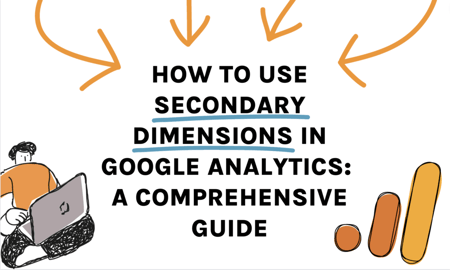Maximize Your Reporting Accuracy With Second Measurements
In the realm of information evaluation, the quest for accuracy and deepness is a perpetual search. Second measurements supply a gateway to augmenting reporting precision by supplying a multifaceted lens through which to check out data. Visualize the power of unraveling elaborate layers of information that exist past the surface area metrics, offering a richer tapestry of insights waiting to be checked out. As we begin on this trip of leveraging second measurements, the landscape of reporting precision beckons with guarantees of improved clearness and tactical decision-making.
Relevance of Second Dimensions
Utilizing additional dimensions is necessary for boosting the depth and granularity of reporting insights in information analysis. By including second dimensions right into data analysis processes, services can acquire a much more detailed understanding of their efficiency metrics. These additional measurements give a more thorough sight of the primary information, enabling an extra nuanced interpretation of patterns and fads. Additional dimensions make it possible for experts to sector and filter data based on specific criteria, providing an extra personalized and targeted evaluation.
Moreover, additional dimensions aid in determining connections and connections that might not be immediately noticeable when analyzing information with only key dimensions. This deeper degree of understanding can result in more educated decision-making and strategic planning within a company. By leveraging second dimensions successfully, companies can discover covert chances, identify areas for enhancement, and optimize their total efficiency.
Implementing Additional Dimensions
To include additional dimensions properly right into information evaluation procedures, businesses must embrace a structured technique that aligns with their reporting purposes and logical goals. Implementing secondary measurements includes picking the ideal measurements that offer deeper insights right into key data metrics. It is vital to determine which secondary dimensions will certainly improve the understanding of the main information being examined. Organizations need to think about elements such as the kind of information being collected, the certain metrics they intend to examine, and the crucial performance indications (KPIs) they are concentrated on improving.
In addition, organizations need to guarantee that the chosen second measurements relate to the key information and supply purposeful context without creating information overload. Executing secondary dimensions additionally calls for specifying clear analytical questions that the extra measurements will assist address. By structuring the application process around these factors to consider, companies can take full advantage of the worth originated from second dimensions and improve the precision and depth of their coverage.
Analyzing Information With Additional Measurements

One secret element of examining data with secondary measurements is to ensure that the picked measurements line up with your specific logical goals. Selecting the right second dimensions can supply context and subtlety to your key data metrics, enabling you to draw even more precise final thoughts and make notified choices based on the insights got.
Furthermore, leveraging second measurements efficiently can aid in recognizing outliers, recognizing the effect of various variables on your key performance indicators, and obtaining a thorough sight of your information landscape. By delving right into data with additional dimensions, you can improve the depth and high quality of your analysis, leading to even more robust coverage and workable outcomes.

Enhancing Insights Via Second Measurements
Discovering information through second dimensions not only grows evaluation yet likewise amplifies the capacity for discovering important insights that can dramatically improve reporting accuracy. By adding additional measurements to your reports, you visit their website can gain a much more comprehensive understanding of the connections between various data factors. When assessing data with primary dimensions alone., this enhanced viewpoint allows you to recognize patterns, fads, and correlations that may have been ignored.

Fundamentally, leveraging additional measurements equips you to draw out richer understandings from your data, enabling you to make more informed choices and enhance your reporting precision.
Ideal Practices for Second Measurements
Using secondary measurements successfully requires cautious factor to consider of crucial strategies to enhance information analysis and reporting accuracy. When applying additional measurements, it is necessary to align them with your primary metrics to derive purposeful understandings.
One more crucial practice is to experiment with different this website mixes of second and key measurements to discover distinct relationships and patterns within your data. This repetitive technique can expose beneficial understandings that might have been ignored or else. In addition, it is necessary to frequently review and improve your secondary measurement choices to ensure they stay relevant and aligned with your developing reporting needs.
Moreover, documenting the rationale behind your option of additional measurements can supply context for future analysis and help with collaboration within your team. By complying with these ideal techniques, you can take full advantage of the efficiency of second measurements in boosting your reporting precision and driving informed decision-making.
Verdict
Incorporating additional measurements in information evaluation is critical for optimizing reporting accuracy and gaining much deeper understandings into performance trends. By tactically picking additional data points, analysts can make and uncover concealed connections educated decisions. secondary dimensions. Executing finest techniques for second dimensions enhances the depth of evaluation and improves the importance of reporting results. This method inevitably causes much more nuanced and accurate interpretations of data, causing even more educated decision-making.
Moreover, second dimensions aid in identifying correlations and relationships that may not be instantly evident when evaluating information with only key dimensions. Applying secondary dimensions includes selecting the appropriate measurements that supply much deeper insights into key information metrics. Applying additional measurements likewise requires specifying clear logical inquiries that the extra dimensions will help address.When evaluating data with secondary dimensions, it is crucial to concentrate on removing beneficial understandings that complement primary data metrics. By including second dimensions into your evaluation, you can uncover patterns, patterns, and partnerships that may not be noticeable when looking at the data from a key dimension alone.